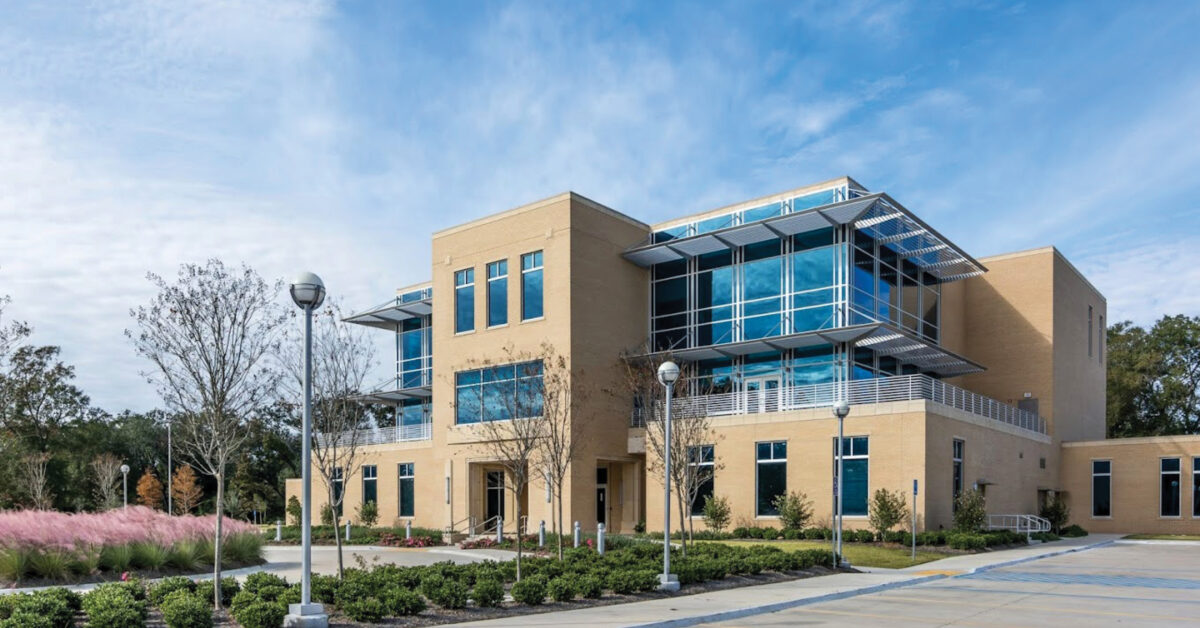
Weathering Stress
March 2022
Family Works – Local Business Legacies
March 2022Plan Your Career
Over three million high school seniors will graduate this spring, according to a Harvard University report. Some of you may have known what you wanted to be when you grow up since you were a kid, but for others, making decisions about your future can be a daunting task. What career are you best suited to? How do you choose a college? How will you pay for your education? And what about post-college money-management? In this special section on Planning your Career, our intention is for you find some answers to these questions and more.
Find Your Path
with McNeese State University’s Office of Career and Professional Development Services
At McNeese’s Office of Career and Professional Development Services, most students who stop by only want to know one thing – how will this help me get a job? But they might want to think about the services the office offers a little differently. The office is not just a job placement service. It also provides career and professional development services, emphasis on the development. Their approach is two-fold. They advise students on what they can do with their abilities and help them learn the professional skills they need to land the jobs they want.
Regarding advisement, that means career exploration. Many students have a one-track focus on employment as a major detriment to their growth. Engineers might think the only jobs open to them are at the plants, while English majors might think the only jobs they can get are in academics. With tools like “What Can I Do with This Major?” and the employer network and job postings in Handshake, the office can show students there are a lot of different paths open to them and how to take those paths.
To that end, the office also offers free access to TypeFocus – a test that shows students the career paths they’re most suited to based on several factors, including personality, aptitude, interests and skills. Through Handshake, the office sends out emails to relevant majors about career opportunities in the area and hosts events and presentations for students.
Perhaps most importantly, the office offers multiple events every semester so all students – from first-year students to seniors – have opportunities to talk one-on-one with employers in Southwest Louisiana and from across the country. These are great opportunities not only for students to see what’s out there, but to practice their interviewing skills.
Career Expo is the largest event with all employers welcome and all majors represented. Internship Soirée is for sophomores and juniors who are considering an internship and the area businesses that have internships available. Education Professionals Recruitment Day is for education, school counseling and any degree candidates interested in teaching as a profession to meet with area school districts. There are also part-time job fairs in the fall semester for students who are new to the area or are looking for a little extra work experience.
The office’s services aren’t limited to current students. Alumni are also welcome and offered the same opportunities as students, free of charge. Alumni can even just drop in; most of the time an appointment is not necessary.
The office offers weekly resume workshops as well as professional writing seminars, internship information sessions and mock interviews to prepare students for Career Expo and Internship Soirée. The services offered are most useful for students who take advantage of them as often and as early as possible. The staff members strive to get students focused early and even talk to parents and have sessions on career and professional development at orientation. A long, stable career starts early, and the Office of Career and Professional Development wants to give students that opportunity.
Crunching the Numbers:
Tips for Funding a College Education
It is no surprise that most parents and students alike experience major sticker shock when exploring college costs. According to the U.S. Census Bureau of Labor Statistics and the National Center for Education Statistics data, college costs have increased by a whopping 169% over the past four decades.
Starting a college fund while a child is young is always a good idea, but what if it’s not enough, or what if you don’t have the luxury of a parent-funded education? That’s where existing financial aid and scholarship dollars can help fill the gap.
FAFSA
To start, complete a Free Application for Federal Student Aid or FAFSA available at FAFSA.gov. Most higher education institutions require this information as part of their application process, so even if you think it might not help, it’s always a good idea to complete it. Plus, you never know what you may qualify for as you move through a college’s enrollment process.
Completing a FAFSA will determine what federal aid you qualify for, such as the Pell Grant. Grant dollars are not paid back and can be used to help cover tuition, books, fees and more.
The FAFSA will also determine if you qualify for the federal student loan program. However, not all academic institutions participate. Student loans typically need to be paid back to the federal government once you finish college or are no longer enrolled.
If you need support completing a FAFSA and know where you will attend college, visit the institution’s enrollment office for assistance. They have knowledgeable staff to guide you through the application.
TOPS
If you’re a Louisianian, you have likely heard of TOPS or the Taylor Opportunity Program for Students. TOPS is a state-funded scholarship program for Louisiana residents (i.e., those who live in Louisiana the last two years of high school) who attend an in-state public college or university, community college, Louisiana approved Proprietary and Cosmetology Schools or Institutions in the Louisiana Association of Independent Colleges and Universities.
Four different award components are available, including the TOPS Opportunity Award, TOPS Performance Award, TOPS Honors Award and TOPS Tech Award. A variety of factors, such as GPA, ACT scores, planned area of study post-high school, etc., impact which award applies to your situation. TOPS may be available for up to eight semesters and the award amount depends on legislative approval per academic year.
For more information or to apply,
visit mylosfa.la.gov.
Scholarships
A variety of scholarship opportunities are available, and their eligibility requirements are as diverse as the people applying for them. Your high school guidance counselor can connect you with aid dollars through community scholarships or national scholarship programs. Once you know which college or university you plan to attend, check with the institution’s Financial Aid Department to find out what scholarships it offers to students.
SOWELA Technical Community College, for example, has a foundation that awards scholarship dollars solely to SOWELA students. Students complete a one-page application to determine eligibility and are asked for a parish residency, area of study, future goals, financial needs and so on. Awards are then made based on academic merit, achievements, and/or financial need. Scholarship awards through the Foundation will be increasing in the upcoming year thanks to a $200,000 anonymous donation that boosted the college’s existing scholarship funds by over 30%.
“After working in higher education for many years, I recommend that students look at their college education as an investment,” said Allison Dering, SOWELA Director of Enrollment Management and Financial Aid. “To determine the return on that investment, students should evaluate realistic future salary earning potential, tuition costs, and the potential debt that could be incurred while attending. Students should always maximize every opportunity to apply for grants, scholarships, and jobs on campus before considering borrowing student loans.”
Don’t let that initial price tag scare you when determining your educational options. Several financial aid and scholarship opportunities exist, as do college and university tuition options. Weigh this venture much like you would any other: consider the present costs and the potential for future gain. Explore your options fully before short selling your tomorrow today.
Eligible students can receive up to $3,200 in financial aid per academic school year
Beginning in July 2022, eligible students can take advantage of Louisiana’s “M.J. Foster Promise Program,” a financial aid award given on a first-come, first-served basis.
Funds from the program may be used by students over a three-year period to cover their tuition and fees. Qualifying students are eligible for a maximum of $3,200 per award year with a lifetime maximum benefit of $6,400. Students must be 21 years or older to qualify.
Named after former Louisiana Governor Mike J. Foster, the “M.J. Foster Promise Program” is a new $10.5 million annual state fund that will provide financial support for students to earn credentials that align to high-demand jobs in the state’s growing industry sectors such as healthcare, construction, transportation and logistics, and more. The goal of the program is to cover community and technical college tuition for thousands of Louisianians.
“Historically, Louisiana has provided tuition assistance to graduating high school seniors in the form of the TOPS scholarship,” said Allison Dering, SOWELA director of enrollment management and financial aid. “Our state is now giving adult students the same opportunity to receive funding that will provide tuition assistance. The M.J. Foster Promise Program will open a new door to education and skills training for many residents who want to start a new career.”
More information and a full list of SOWELA programs eligible for financial aid under the new program can be found at https://www.sowela.edu/admissions/financial_aid/mj-foster/.
Louisiana Offers Eligible Students Financial Aid through the
“M.J. Foster Promise Program”
College Grads
the Wallet is in Your Hands
by Kristy Como Armand
Graduation season is here and freshly degreed college graduates will soon be embarking on the next chapter of their lives as they begin their careers. Life after the final semester typically ushers in more independence, which typically means more responsibility and more control over personal finances.
“College life certainly provides a taste of what’s ahead, but many students are fortunate enough to have the backing and support of their parents while in school and are not operating fully on their own funds. Receiving that degree is usually the catalyst marking the transition to full financial independence and responsibility,” says Jonathan Boudreaux, Senior Vice President with Lakeside Bank. “A college education does many things, but one of the things it doesn’t always do is prepare students for all the challenges that come with taking control of your own finances.”
According to Boudreaux, the best way to start is to create a personal budget. Even if you have been working from a budget, you’ll need to adjust to this new phase of your life. Boudreaux explains that a budget doesn’t mean you calculate bills and expenses in your head – it’s an actual document (on paper or online) that details your bills, expenses and spending habits in black-and-white. There is no one way to create a budget. Some people prefer spreadsheets while others might prefer an ‘old-school’ ledger they write in. There is also a wide variety of online apps and programs to help you set up a budget. “The key to budgeting success,” says Boudreaux, “is finding a method that works for you and that you will stick to.”
Once you have a budget, Boudreaux says the next stop is making sure you have a clear understanding of how much disposable income you have. “A vital aspect of effective budgeting is keeping track of what’s going in and out. If you swipe your debit card ten times in a week and transfer funds through a mobile app like Venmo or PayPal and forget to document those transactions in your budget, you’re already falling off the financial train. ‘If you spend it, enter it,’ is a good budgeting rule to follow, particularly in the early stages of setting up your monthly budget and shouldering the financial responsibilities of the real life that awaits you post-graduation.”
Another good post-graduate idea is to get a copy of your credit report. Chances are you will now need access to more credit, whether it’s buying a car or opening a credit card. It’s a good idea to find out where you stand. If your credit score is low, you may find it difficult to rent an apartment or finance a vehicle. If you haven’t accumulated much credit during your college years, you may find that your score has been affected by that as well. “Also, as a college graduate, you probably haven’t had much time to build up a solid credit history for creditors to hang their hats on,” says Boudreaux. “Whatever your situation, it’s a good idea to know what your score is and what you can do to get it to the highest level possible.”
Speaking of credit, now is not the time to fall into debt. Chances are, you already have some. Resist the temptation of getting more, stresses Boudreaux.
“The average college graduate in the United States has close to $30,000 in debt when they graduate,” says Boudreaux . “It can be tempting to accumulate even more, especially on an entry-level salary. But, if at all possible, don’t pile on more debt onto your existing obligations. If you do, you could be 40 or older old before all of its paid off.”
Boudreaux says another good step in establishing a solid foundation for your future financial success is establishing a relationship with a banker. “A trusted banker can help you analyze your budget and current finances, as well as your savings and credit-building goals as you put your college degree to work to secure your future.”
For more information about banking services at Lakeside, call (337) 474-3766 or visit wwwl.mylksb.bank.
Working through College
Helps Students Prepare for the Real World
Each year, parents send their sons and daughters off to college with high hopes that in four years – give or take – they will earn a degree and embark on successful careers. But while moms and dads may fret most about grades and study habits, they can give their offspring a real boost if they also insist the students carry some of the financial burden for college, says Matt Stewart, an entrepreneur and co-founder of College Works Painting, an internship program that provides practical business experience for college students. That means getting a job – either during the school year or over the summer break, or both.
“College students are much more invested in the experience if they have to help pay for college, rather than have mom and dad take care of everything for them,” Stewart says. “There’s a natural tendency to work a little harder on classwork when at least a part of the tuition or dorm room costs come out of your own pocket.” But beyond that personal-responsibility aspect, it’s worth noting that businesses are seeking job candidates with real-world work experience. “Those on-the-job lessons are invaluable,” Stewart says. For example, interns with College Works Painting operate their own house-painting business with hands-on guidance from mentors.
The benefits for students who work their way through college include:
A regular paycheck. The rising cost of higher education has put paying the full price of college out of reach for many parents, and scholarships and grants often provide only a small percentage of the costs. The more students can pay themselves, the lower their student-loan debt will be when they enter the workforce.
Practical experience. Nothing prepares you for work like work. A classroom can train students on certain skills necessary for their career choice, but on-the-job experience is just as valuable. Even if a part-time job is unrelated to career aspirations, a student might learn such skills as collaboration, time management and customer relations.
Resume enhancement. One of the weaknesses recent college graduates sometimes have is their resumes can be skimpy. A few summer jobs can help tremendously, giving managers who might consider hiring you more confidence that you have experience beyond listening to professorial lectures and cramming for final exams.
Additional references. Hiring managers want to talk with people who know your work habits, and while it’s nice that a favorite professor or a high school football coach is willing to say good things, it’s even better to have references who can discuss relevant job skills.
“Having any job can be beneficial, but if you can, try to land an especially challenging job or internship,” Stewart says. “When you graduate, you’re going to face stiff competition in the job market. The more you’ve been able to stretch yourself past your comfort zone and develop new skills, the greater the odds are that you’ll be the one picked out of all the applications that come pouring in.”
For more information on College Works Painting, go to www.collegeworks.com/about.
10 Things to Know
Before You Take Out Student Loans
Taking student loans can be an effective way to pay for some of your college education—but they do come with some pretty big responsibilities. Personal finance guru Eric Tyson, MBA, shares some tips students (and parents) should keep firmly in mind.
Student loans seem like a financial necessity at first glance. But personal finance expert and best-selling author Eric Tyson warns they can be tricky, especially if you don’t fully understand what you’re getting into.
“Student loans aren’t inherently ‘bad,’” says Tyson, author of Paying For College For Dummies® “They make sense for many people. But college is expensive and using loans to pay for it means debt—sometimes a lot of it. Students and parents need to understand what they’re agreeing to before they sign on the bottom line.”
A few facts:
The total amount of student loans outstanding in the U.S. has surpassed $1.5 trillion, making it the second largest form of debt outstanding by consumers, exceeded only by mortgage debt.
More than one million student loan borrowers default annually on their loans, and only 57 percent are current on their payments.
According to LendEDU’s analysis of student loan debt figures at nearly 1,000 four-year private and public higher education institutions across the U.S., the average graduating borrower received their diploma and left campus with $28,565 in student loan debt.
Those are some hefty numbers, and they underscore exactly why you need to know some important facts and instructions about the payment process. Here are a few tips to remember before taking out a loan and when you’re ready to begin making payments.
Keep close track of your loans. They can get lost (and you can get behind) in the shuffle. “Especially if you’ve taken loans from numerous sources, total up the amount of debt accumulated,” says Tyson. “Debt surprises are rarely good! And be sure you track all your student loans as they may well be represented by multiple lenders and/or servicers by the time that college degree is earned.”
Have a frank discussion about cosigner responsibilities. If parents have cosigned student loans with their son or daughter, everyone who has cosigned is legally responsible for the repayment of those loans. Of course, different families will have different expectations as to who will make the repayments. Put an agreement in writing to ensure that everyone is clear on the plan and so there’s some accountability. That’s not to say that a written plan can never change; with discussion and agreement, your plan can be modified.
Know the loan terms (and when payments begin) up front. When you take out a federal government student loan, you sign a federal student loan promissory note that spells out the terms and conditions of the loan. Generally, six months after graduation, federal student loan payments begin. Private loans work differently and have different terms and conditions; if you are considering taking out a private loan, take time to understand the terms before committing.
Save money (and make on-time payments) with your loan’s auto-pay feature. When your student loan repayments begin, set them up for automatic payment. This feature drafts the money from your bank account monthly on or before the payment due date. In addition to ensuring that you don’t have late payments or missed payments, most loan servicers or lenders will knock 0.25 percent or so off the effective interest rate you’re paying for using auto payment. Some private lenders may reduce the rate a tad more than that.
Understand loan forgiveness conditions. There are several conditions under which a portion or all of government student loans can be discharged or forgiven. Most commonly this occurs because the student-borrower is working in a field of public service. However, this may also occur when the student-borrower suffers adverse health conditions.
Know your federal loan repayment options. There are eight different repayment plans/options for your federal student loans. A number of these plans are sensitive to and based upon the student’s income relative to the amount of student loans he has outstanding. The repayment schedule, however, is not tailored to the local cost of living (strangely, there’s an adjustment only for students in Alaska and Hawaii). So, students-turned-workers who are living in high-cost urban areas like New York City, Chicago, Boston, Washington, San Francisco, and so on don’t get any special breaks. Your salary may be a bit higher working for employers in those high-cost areas, which actually undermines your chances and ability to qualify for income-based repayment plans.
Stay open to the possibility of refinancing. By the time a student graduates and begins loan repayment, interest rates on new, comparable loans may be lower. When that occurs, it may be possible to refinance some of your student loans with a private lender at a lower interest rate than you are currently paying.
Ask for relief if you need it. Hard times can happen, and as a result, you may struggle to make your required monthly loan payments. The good news is, you may qualify for some relief from making your federal student loan payments until you can afford to do so again. There are two ways in which you may qualify for what is called “forbearance” of your federal student loans. You can request general forbearance if you are temporarily unable to make your scheduled monthly loan due to financial difficulties, medical expenses, change in employment, or other reasons acceptable to your loan servicer. General forbearance is granted for no more than 12 months at a time. Under other circumstances (for example, you are serving in a medical or dental internship or residency program, and you meet specific requirements), you may be eligible for mandatory forbearance, in which your loan servicer is required to grant the forbearance.
Make use of the student loan interest deduction. The student loan interest deduction is a tax break for college students and their parents who took on debt to pay for school. It allows you to deduct up to $2,500 in interest paid from your taxable income. Due to the ongoing pandemic, interest on most federal student loans has been paused since March 13, 2020. However, you may be able to claim payments made toward an accrued or capitalized federal loan interest balance and interest payments made on loans that aren’t eligible for this relief, like private student loans.
You can pause your loans if you return to higher education. Getting a college degree may not be the end of a person’s higher education. Returning to school at least half-time enables those who have subsidized federal government student loans to hit the pause button on those loans. Remember that with subsidized federal student loans, interest does not accumulate, and no loan payments are due while the student is in school. However, private student loans and nonsubsidized federal student loans are, of course, a different matter. The interest keeps accumulating on those even if a former college graduate returns to school at least half-time. And, with some private student loans, you won’t be able to defer making payments and will need to make payments regardless of your student status.
“If you take out student loans for college, they will be a part of your life for years to come, and you should approach them with eyes wide open,” concludes Tyson. “But if you handle them with responsibility, they can be a smart investment in your future.”






